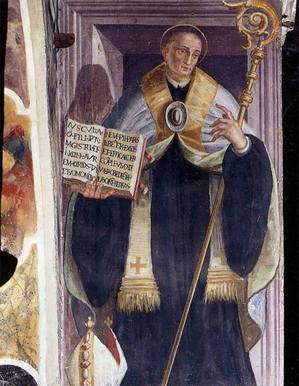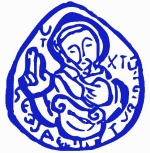 The Church recalls the witness of an emperor and a Benedictine Oblate, Saint Henry (972-1024), Duke of Bavaria. Henry was crowned king in Rome by Pope Benedict VIII in 1014. It is said that Henry was assisted by the saints throughout his life but especially at Mass when he was anointed king. He was an insightful leader, lay man who had concern for the discipline of the Church and who had love for the Benedictine monastic life. He was a supporter of Cluny's reforms. It was through Saint Henry that the King of Hungary and later saint, Stephen, met Christ and was baptized.
The Church recalls the witness of an emperor and a Benedictine Oblate, Saint Henry (972-1024), Duke of Bavaria. Henry was crowned king in Rome by Pope Benedict VIII in 1014. It is said that Henry was assisted by the saints throughout his life but especially at Mass when he was anointed king. He was an insightful leader, lay man who had concern for the discipline of the Church and who had love for the Benedictine monastic life. He was a supporter of Cluny's reforms. It was through Saint Henry that the King of Hungary and later saint, Stephen, met Christ and was baptized.Benedictine saints & blesseds: July 2011 Archives
 The Church recalls the witness of an emperor and a Benedictine Oblate, Saint Henry (972-1024), Duke of Bavaria. Henry was crowned king in Rome by Pope Benedict VIII in 1014. It is said that Henry was assisted by the saints throughout his life but especially at Mass when he was anointed king. He was an insightful leader, lay man who had concern for the discipline of the Church and who had love for the Benedictine monastic life. He was a supporter of Cluny's reforms. It was through Saint Henry that the King of Hungary and later saint, Stephen, met Christ and was baptized.
The Church recalls the witness of an emperor and a Benedictine Oblate, Saint Henry (972-1024), Duke of Bavaria. Henry was crowned king in Rome by Pope Benedict VIII in 1014. It is said that Henry was assisted by the saints throughout his life but especially at Mass when he was anointed king. He was an insightful leader, lay man who had concern for the discipline of the Church and who had love for the Benedictine monastic life. He was a supporter of Cluny's reforms. It was through Saint Henry that the King of Hungary and later saint, Stephen, met Christ and was baptized. "St. Benedict's is best understood as the spirituality
of ordinary life... The Benedictine is a spirituality of work: man's by labor,
God's by prayer." (John Senior)
"St. Benedict's is best understood as the spirituality
of ordinary life... The Benedictine is a spirituality of work: man's by labor,
God's by prayer." (John Senior)
 Today is the 31st anniversary of the foundation of Fraternity of Communion and Liberation. The narrative of the Fraternity's founding is told in "The Greatest Grace in the History of the Movement" by Giorgio Feliciani (Traces, February 2007). Here's the story.
Today is the 31st anniversary of the foundation of Fraternity of Communion and Liberation. The narrative of the Fraternity's founding is told in "The Greatest Grace in the History of the Movement" by Giorgio Feliciani (Traces, February 2007). Here's the story.
A priest in the direct service of the Holy See, Monsignor Mariano De Nicolò, currently Bishop of Rimini [he retired 3 July 2007], happened to review, as part of his official duties, a file that illustrated and documented the Movement's desiderata. Feeling that these aspirations deserved attention and further study, he suggested to Father Francesco Ricci, who at the time was sharing responsibility for the Movement with Father Giussani [for more about this priest, who died in 1991, see Francesco Ricci. Una passione, cento passioni, San Martino in Strada, Lit. Citienne, 1996], that he consult with Monsignor Giuseppe Lobina, an expert in Canon Law who, along with a solid formal training, had an unusual amount of experience with ecclesiastical praxis.
This advice was promptly taken and, only a few months later, Monsignor Lobina, after acquiring all the necessary information in various meetings with CL figures and Father Giussani himself, was drawing up what would soon be the Statute of the Fraternity, which has remained largely unchanged up to now.
Monsignor Lobina also undertook to find the ecclesiastical authority willing to approve the Movement, and found him in Abbot Martino Matronola, who, as provost [abbot] of the monastery of Montecassino, had the same powers over the surrounding territory as the bishop of a diocese. This acceptance was even more welcome because Father Giussani felt that the concept of his Movement was very close to that of the Benedictines (see Giussani, op.cit., pp. 74-75).
The formal establishment of the Fraternity came shortly thereafter in a very discreet, unassuming way. On July 11, 1980-the solemnity of Saint Benedict, Patron of Europe, on the fifteenth centenary of his birth-a small group of twelve stood together with Father Giussani in front of the Abbot to be constituted as a canonical association. On that same day, Monsignor Matronola,* by a specific formal decree, granted juridical status in the Church to the ecclesial movement called "Fraternity of Communion and Liberation" and approved its statutes and "works of apostolate and individual and social formation," placing it under the "protection of the Immaculate Virgin and our Patron Saint Benedict" (see the Bollettino Diocesano di Montecassino, no. 3, 1980, pp. 223-224).

One of my favorite parts of the Saint Benedict's hagiography (iconography) is the narrative of the "man of God" (Benedict) and the raven. It is related by Saint Gregory the Great (+603) that in the wilderness Benedict fed a raven with some a portion of his bread. When a jealous and wicked priest tried to kill Benedict with poisoned bread, Benedict coached the raven to take the deadly bread to place where it couldn't harm another. The raven complied.
In his Dialogues Gregory writes, "Then the raven, opening its beak wide and spreading its wings, began to run around the bread, cawing, as if to indicate that it wanted to obey but was unable to carry out the order. Again and again the man of God told him to do it, saying, 'Pick it up, pick it up. Do not be afraid. Just drop it where it cannot be found.' After hesitating a long time, the raven took the bread in its beak, picked it up and flew away. Three hours later it came back, after having thrown the bread away, and received its usual ration from the hands of the man of God."

